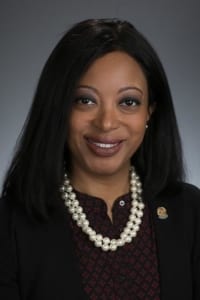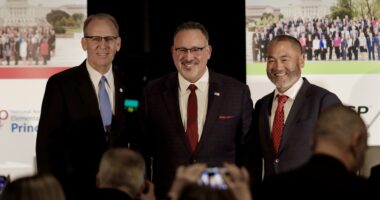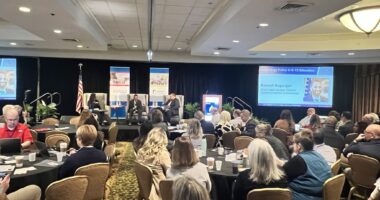NAESP and NASSP Presidents Talk About Diversity
A conversation with Kimbrelle Barbosa Lewis and Robert Motley.

We recently sat down with two eminent school leaders to discuss the importance of diversity in school leadership. Kimbrelle Barbosa Lewis is the principal of Cordova Elementary in Cordova Tennessee as well as the president of the NAESP. Robert Motley is the principal of Atholton High School in Columbia, Maryland and president of the National Association of Secondary School Principals (NASSP). They each shared their path to leadership in addition to valuable advice to others who want to pursue principalship.
Q. What motivated you to pursue a career path towards principalship?

Kimbrelle Barbosa Lewis
Kimbrelle: I started out in banking. However, in the first four years after I received my undergraduate degree, I found that I enjoyed the time I spent tutoring elementary school students more than my position at the bank. I went back to get my certification in education, and as soon as I became a teacher, I embraced that opportunity. After my first year, I went right back to get my Master of Education in Curriculum and Instruction. I went on to pursue my EdS degree and now my doctorate in leadership. What I loved most about my job was leading, whether I was an instructional coach for teachers or helping to lead a school. That started me on my path into principalship.

Robert Motely
Robert: I had a different journey, fueled out of a feeling that I could do more. My first three years of teaching, I worked in a district of minority students at a Title I school. I felt that the principal wasn’t serving the school and the students deserved more. After my first year, I went back to get my master’s degree. When I began teaching at Atholton High School, I thought, wow, this is paradise. This is what it’s supposed to be like. In order to finish my master’s degree, I went to my principal and told her that I needed to do an internship. My principal was so excited I wanted to pursue administration that she thrust me into new positions. The next thing I knew, I was chair of the school improvement team and leading many different initiatives. In four years, I was named assistant principal. Once I got that bug of having an impact on the school, it just grew and grew. Five years later I got the principalship and was ready to lead my own school.
Q. What advice do you have for someone who might be in the same position as you were in when you started out?
Robert: I always ask people the reason they want to get into administration and leadership. What is your purpose? For me it was recognizing that the students I was working with weren’t getting the full breadth of what they deserved. Now, I am known as the champion for that kid who doesn’t have a two-parent home. Just because he doesn’t have an advocate at home doesn’t mean that he’s not going to have one at school. That’s where I step in. So I always ask about a person’s passion, because this is a tough job. People are going to want to tear you down, especially if you are an administrator of color, so you’ve got to have strong convictions.
Kimbrelle: I’ll start by saying you have to have a heart for kids. That has to be your ultimate motivation. A lot of times, people go into administration to get out of the classroom. However, as a school leader, every decision I make is tied directly to how it’s going to impact my students. All of my jobs except one have been in Title I schools.
When I was called to be a principal, I moved to a school that was Title I, and 95% of the students were considered impoverished. My entire school lived in great poverty. When you are taking on leadership, you are taking on what every one of those students needs, lacks and requires. If that’s not your motivation then you’re not ready to be a leader. Being a leader can be isolating. It can be tough work, every day, all the time, and no decision is easy. If you’re not quite there, that’s OK too. A great thing you can do is shadow a principal and really see if that’s what you want to do or if you want to enrich your motivation first.
Q. What are your thoughts about increasing the pipeline of diverse school leaders?
Robert: Number one, I think my current role is something in and of itself. Oh wow, there’s a Black president for NASSP. And whatever I can do to lead this charge to promote diversity in our organization, I’ll do. Our board has done a fantastic job of increasing diversity on the board, which is where the president elect comes from. So if you increase diversity on the board, you increase the likelihood that your president or president-elect will be a person with a diverse background as well.
I have a staff of 170 teachers and staff and only one Black male on my staff. When I got here, there were no Black teachers. He’s in his second year of teaching and he’s been very motivated. He’s already taken over the leadership of our Black Student Union, which is great because ultimately our leaders of color come from our teachers of color, right?
Kimbrelle: As far as NAESP and NASSP, I would like to say that the fact that Robert and I are both people of color currently serving as presidents is very significant. I think it speaks to the opportunity in our organizations as well as their priorities. Along those lines, NAESP has a diversity arm to our Center for Innovative Leadership So we have Black and Brown leaders who lead and engage principals of color on a regular basis.
We know what has always happened in our country with people of color in terms of discrimination and systematic injustice, and that came to light last summer. Both of our organizations have responded to that. NAESP has responded through the National Taskforce on Race and Equity, which has done a lot to support our member needs and principal needs when it comes to leadership and talking about implicit bias, how we do equity audits on leadership and how our teachers are teaching. I’m really excited.
Regarding the pipeline, I’m from a large district in an area of the state that has a large Black and Hispanic population. We are the largest district in the state with the most people of color and we have a unique perspective in that we do have a lot of leaders of color. But I think throughout our state, we might not see that always reflected. I think that’s important wherever you are, whatever state, whatever district, superintendents and school boards need to know that developing diverse leadership is important. Several years ago, my district partnered with the University of Memphis, which had an urban leadership program. There were people who were very interested in the program—who weren’t even in the district—so they could understand what their students needed and what their schools needed. District leaders need to do similar things and understand that there are many, many people with diverse backgrounds who are prepared to lead.
Q. Is there anything else you would like to add?
Robert: I just know that what we are doing is only at the beginning of what we can accomplish as an organization. NASSP recently hired a new CEO who is Hawaiian. Overall, I’m thrilled with the direction in which we are moving.
Kimbrelle: Neither Robert nor I take our responsibilities lightly. We want everyone to know that we are a reflection of many other talented principals and leaders in our districts and across our country. I’m very happy to represent their voices.




